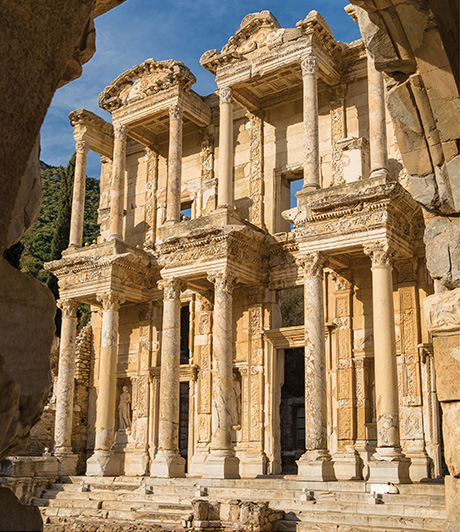
ALIAKSANDR MAZURKEVICH / ALAMY STOCK PHOTO
One of the largest libraries in antiquity, the Library of Celsus, found at the site of Ephesus on the western coast of Turkey, was commissioned in 114 CE to commemorate the Roman consul and governor Tiberius Julius Celsus Polemaeanus. Both a mausoleum and library, the building held around 12,000 scrolls, rivaling the libraries of Alexandria and Pergamum. The library was destroyed in 262, possibly during the Gothic invasion of the city. Today, all that remains is the façade, elaborately decorated with carvings and statuary. The two-story edifice boasts 16 columns built using a forced perspective technique that made the building and its features appear larger than they actually are.
One of the largest cities in the Roman world, Ephesus was a hub of communication, pilgrimage, and trade and was the capital of the rich Roman province of Asia. Perhaps this is why the city was so prominent in the third missionary journey of Paul, who spent two and a half years there (Acts 19). Although the library was not constructed until decades after Paul’s death, the city’s intellectual climate stretched back centuries, creating fertile ground for Paul’s work in the city, which most likely included writing letters to the Corinthians and Philippians.
One of the largest libraries in antiquity, the Library of Celsus, found at the site of Ephesus on the western coast of Turkey, was commissioned in 114 CE to commemorate the Roman consul and governor Tiberius Julius Celsus Polemaeanus. Both a mausoleum and library, the building held around 12,000 scrolls, rivaling the libraries of Alexandria and Pergamum. The library was destroyed in 262, possibly during the Gothic invasion of the city. Today, all that remains is the façade, elaborately decorated with carvings and statuary. The two-story edifice boasts 16 columns built using a forced perspective technique that made the building […]